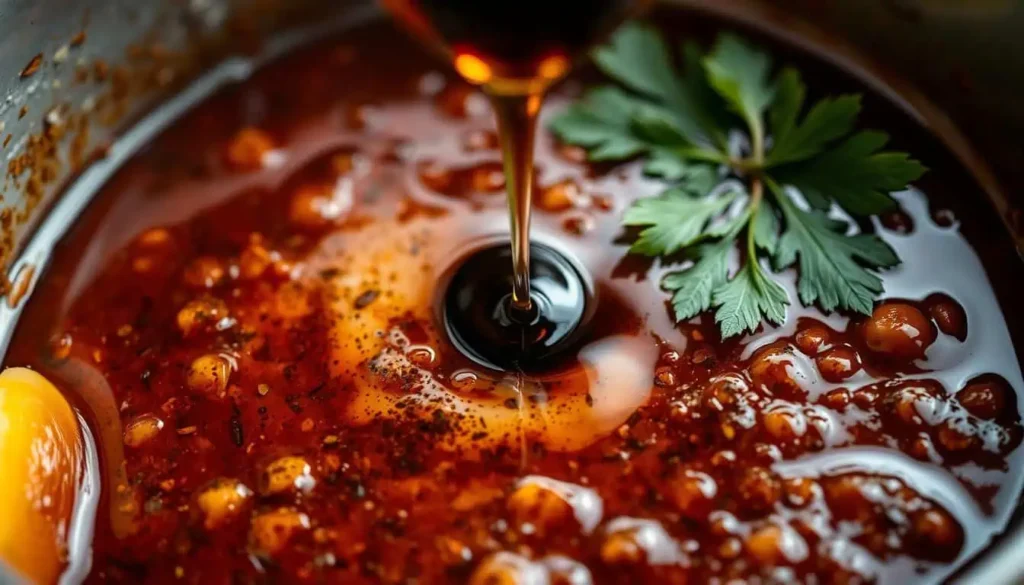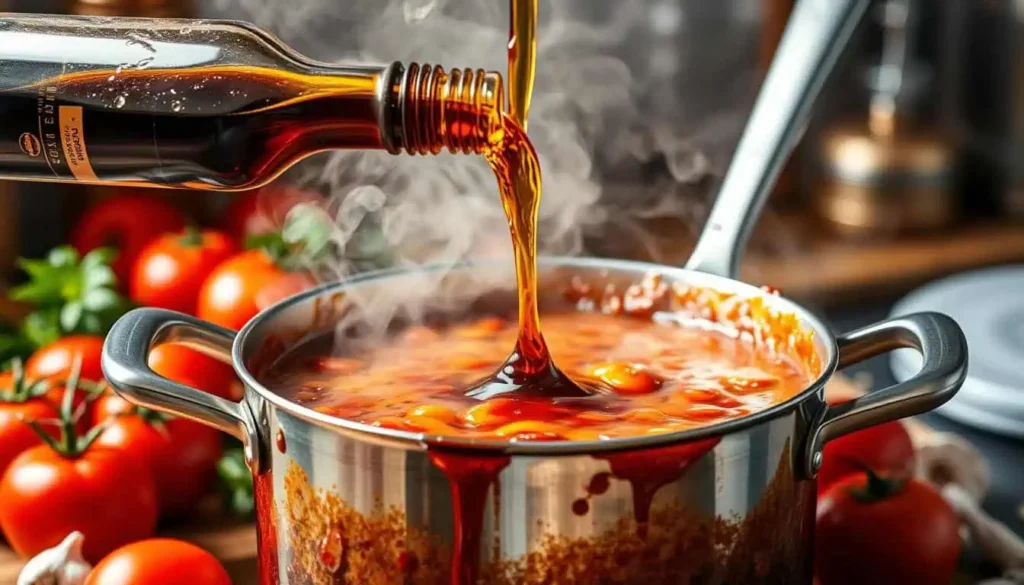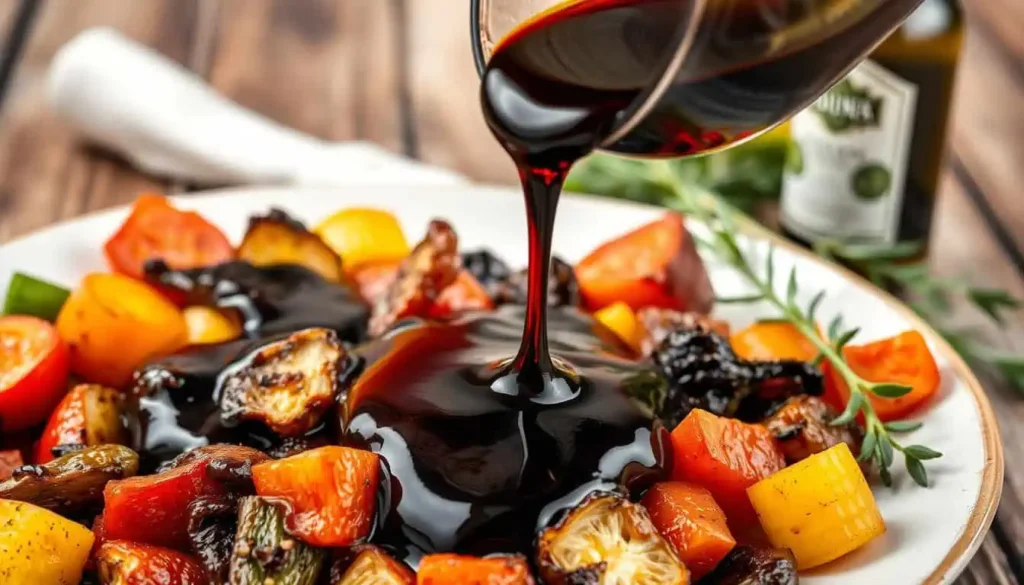What does balsamic vinegar do to a sauce? Balsa vinegar is more than just a kitchen ingredient. It’s a game-changer for sauce flavor. Its complex profile adds depth and nuance to simple dishes. When I’m cooking, I often use this versatile vinegar to transform sauces.
Whether drizzling it over a salad or simmering it into a marinade, balsamic vinegar elevates my dishes. In this article, I’ll explore how balsa vinegar can enhance your sauces. I’ll also share tips on using this flavorful ingredient to its fullest potential.
Key Takeaways
- Balsamic vinegar enhances sauce flavor with its rich, sweet, and tangy profile.
- It plays a vital role in sauce transformation, elevating simple recipes.
- This versatile ingredient is ideal for marinades, dressings, and glazes.
- Understanding the types of balsa vinegar can help improve your cooking.
- Proper measurement and pairing are essential for successful culinary outcomes.
The Basics of Balsamic Vinegar
Balsamic vinegar has a rich history in cooking. Knowing the different types can make our dishes better. Each type brings its own flavors, making simple recipes special.
Learn why vinegar is a secret ingredient in unexpected recipes like cheesecake.
Types of Balsamic Vinegar
There are two main types: traditional and commercial balsa vinegar. Traditional vinegar is aged for at least 12 years, giving it a deep flavor. Commercial vinegar is quicker to make and cheaper, but it’s not as complex. Understanding what does balsamic vinegar do to a sauce begins with knowing these types.
Choosing the right vinegar can change how a dish tastes. It’s important to know the difference between them.
Flavor Profile of Balsamic Vinegar
The taste of balsa vinegar varies by type. Traditional vinegar is sweet and has a mild tang. Commercial vinegar is often more acidic and may have added flavors, influencing how it enhances a sauce.
Using the right vinegar can make a big difference in a dish. It can add a subtle touch or a bold flavor.
| Type | Production Time | Flavor Profile | Price Range |
|---|---|---|---|
| Traditional Balsamic Vinegar | 12 years or more | Rich, complex, sweet, mild acidity | High |
| Commercial Balsamic Vinegar | Few months | Varied, often stronger acidity, may include spices | Low to moderate |

What does balsamic vinegar do to a sauce?
Balsamic vinegar is a game-changer in cooking. It adds a rich, tangy flavor that makes sauces better. It brings complexity that goes well with many ingredients. Knowing how to use it can make your dishes taste amazing.
Enhancing Flavor Profiles
Balsamic vinegar has a unique taste that’s both sweet and tart. It can turn a simple dish into something special. I use it in marinades or on grilled veggies to enhance flavors.
Its versatility is amazing in homemade sauces. It makes them more appealing to eat.
Balancing Acidity and Sweetness
Getting the balance right in sauces can be hard, especially with acidity. Balsamic vinegar is great at balancing this. It adds sweetness to counteract acidity.
This balance creates a dish with harmonious flavors. It’s especially good in salad dressings, where sweet and tangy mix well. Discover how creamy spaghetti carbonara balances richness and acidity.

How Balsamic Vinegar Transforms Sauces
Balsamic vinegar is key in making sauces better. It adds depth in cooking and makes dishes look great. I love how it brings out complex flavors in every dish.
Adds Depth to Dishes
Adding balsamic vinegar makes sauces taste richer. Its sweet and tangy flavors pair well with meats and veggies. Just a little can turn a basic sauce into something amazing.
The mix of acidity and sweetness makes each bite special. It’s a game-changer in depth in cooking.
Impact on Texture and Consistency
Balsamic vinegar also changes the texture in sauces. It makes them feel smooth and luxurious. When cooked down, it creates a glossy look that makes sauces look fancy.
This smooth texture makes even simple sauces feel special. It’s a small change that makes a big difference.
Using Balsamic Vinegar in Different Sauces
Balsamic vinegar is super versatile. I use it in marinades and dressings to make my dishes pop. It brings new flavors and exciting combinations to my cooking.
Marinades and Dressings
For marinades, balsamic vinegar works great with olive oil, herbs, and garlic. This mix makes meats taste amazing before they’re cooked. For dressings, a simple balsamic vinaigrette is a hit. Adding mustard or honey balances the flavors, making any salad better.
Sauces for Meats and Vegetables
Balsamic vinegar is perfect for meat sauces, adding a glossy look and rich taste. I simmer it to make a thick, intense glaze. It also makes vegetable sauces taste better, bringing out the natural flavors of veggies. See how Mississippi Chicken uses vinegar to enhance its depth.
| Type of Sauce | Ingredients | Key Benefits |
|---|---|---|
| Marinade | Balsamic vinegar, olive oil, garlic, herbs | Adds flavor depth, tenderizes meat |
| Balsamic Vinaigrette | Balsamic vinegar, mustard, honey, oil | Sweeter and tangier dressing for salads |
| Meat Sauce | Balsamic vinegar, stock, seasonings | Rich glaze, enhances meat flavor |
| Vegetable Sauce | Balsamic vinegar, fresh vegetables, herbs | Boosts natural flavors of produce |
Tips for Cooking with Balsamic Vinegar
Exploring cooking with balsamic vinegar can really boost your dishes. Knowing which type to use is key for the right taste. Different balsamic vinegars can change a recipe’s flavor, so I keep these tips in mind.
Choosing the Right Variety
I choose traditional balsamic vinegar for richer flavors. It adds depth to sauces and marinades. For everyday meals, commercial balsamic vinegar is great. It adds a tangy sweetness without overpowering.
Measurement Guidelines for Flavor Balance
Measuring balsamic vinegar correctly is crucial for balanced flavors. I start with a tablespoon and taste as I go. This way, flavors grow without being too much. Cooking time also matters; longer dishes need more, quicker ones less.
Common Mistakes When Using Balsamic Vinegar
Using balsamic vinegar can lead to a few common mistakes. Whether I’m trying new recipes or sticking to favorites, these errors can be a letdown. Overusing vinegar and pairing it with the wrong ingredients are big culprits.
Overusing Balsamic Vinegar
One big balsamic vinegar mistake is using too much. This strong ingredient can overwhelm a dish. It’s important to measure carefully to avoid overpowering the flavors. A little vinegar goes a long way in achieving the right taste.
Pairing with the Wrong Ingredients
Another common cooking mistake is pairing balsamic vinegar with the wrong ingredients. For example, using it with bitter greens or strong spices can throw off the flavor. It’s key to understand how to pair ingredients well. This not only improves the dish but also makes it more enjoyable to eat.
Conclusion
In wrapping up my exploration of balsamic vinegar benefits, it’s clear that this remarkable ingredient has the power to elevate any sauce to new heights. Throughout this discussion, I’ve shared how its unique properties of depth and balance can transform a simple dish into a culinary masterpiece. I encourage everyone to experiment with various types of balsamic vinegar, as their distinctive flavors can create exciting new experiences in my kitchen.
In my final thoughts on sauces, I believe that understanding the nuances of balsamic vinegar allows for more intentional cooking techniques with vinegar. By focusing on the balance of flavors, I can craft sauces that not only complement my meals but also delight the taste buds of anyone fortunate enough to share them. This journey into the world of balsamic vinegar is just the beginning, and I’m excited to continue exploring its versatility.
As I incorporate different methods and recipes into my cooking repertoire, it becomes evident that balsamic vinegar is more than just a condiment; it’s a key element that can help create memorable dishes that excite the senses. I look forward to discovering new ways to utilize this powerful ingredient in future culinary adventures!
FAQ
Can you freeze rotisserie chicken to use later?
Yes, you can definitely freeze rotisserie chicken! Freezing it is a great way to preserve leftovers for future meals.
What is the best way to freeze rotisserie chicken?
The best way to freeze rotisserie chicken is to first let it cool down. Then, remove the meat from the bones. Store it in airtight containers or freezer bags. This helps prevent freezer burn and keeps the chicken fresh.
How do I properly freeze rotisserie chicken?
To freeze rotisserie chicken properly, ensure it’s cooled to room temperature. Shred or portion the chicken. Place it in sealed freezer-safe bags or containers with as much air removed as possible. Label the bags with the date for reference.
Can I freeze leftover rotisserie chicken?
Absolutely! Freezing leftover rotisserie chicken is an excellent way to avoid waste and enjoy it in future meals.
What are some tips for freezing rotisserie chicken?
Some tips include using tight seals for freezer bags. Portion the chicken into meal-sized amounts. Use the chicken within three to six months for best quality. Additionally, consider adding some broth to keep it moist!
How do I store rotisserie chicken in the freezer?
Store rotisserie chicken in the freezer by placing it in airtight containers or heavy-duty freezer bags. Remember to label each container with the date and contents, making it easier when you’re ready to use it.
What is the best practice for freezing cooked chicken?
The best practice for freezing cooked chicken includes cooling it entirely. Remove any bones or skin you don’t want to keep. Sealing it tightly in bags or containers is key. Avoid freezing whole chickens if possible, as it’s easier to thaw and use smaller portions.
How can I reheat frozen rotisserie chicken safely?
To safely reheat frozen rotisserie chicken, thaw it in the refrigerator overnight. Then, warm it in the oven or microwave until it reaches an internal temperature of 165°F.
Can I freeze rotisserie chicken with the skin on?
While you can freeze rotisserie chicken with the skin on, removing the skin before freezing will help maintain its texture and flavor when reheating.
How long can I keep frozen rotisserie chicken in the freezer?
Frozen rotisserie chicken is best used within 3 to 6 months for optimal taste and quality. But, it can be safe to eat beyond that time if stored correctly.


1 thought on “What does balsamic vinegar do to a sauce?”
Comments are closed.